From Wikipedia, the free encyclopedia
"House of Rothschild" redirects here. For the film, see The House of Rothschild.
For the German surname "Rothschild", see Rothschild (disambiguation).
| The Rothschild family | |
|---|---|
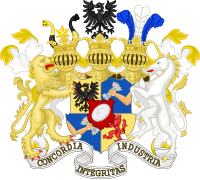 | |
| Ethnicity | Ashkenazi Jewish |
| Current region | Monaco, Luxembourg, France, Austria, Switzerland, Liechtenstein, United Kingdom, United States, Cayman Islands |
| Information | |
| Place of origin | Frankfurt am Main |

A Rothschild house, Waddesdon Manor in Waddesdon, Buckinghamshire, donated to charity by the family in 1957.

Schloss Hinterleiten, one of the many palaces built by the Austrian Rothschild dynasty. Put into a trust fund charity by the family in 1905.

Beatrice de Rothschild's villa on the Côte d'Azur, France
[edit] Family overview
The first member of the family who was known to use the name "Rothschild" was Izaak Elchanan Rothschild, born in 1577. The name means "Red Shield" in old German. The family's ascent to international prominence began in 1744, with the birth of Mayer Amschel Rothschild in Frankfurt am Main, Germany. He was the son of Amschel Moses Rothschild, (born circa 1710),[8] a money changer who had traded with the Prince of Hesse. Born in the ghetto (called "Judengasse" or Jewish-alley) of Frankfurt, Mayer developed a finance house and spread his empire by installing each of his five sons in the five main European financial centres to conduct business. The Rothschild coat of arms contains a clenched fist with five arrows symbolizing the five dynasties established by the five sons of Mayer Rothschild, in a reference to Psalm 127: "Like arrows in the hands of a warrior, so are the children of one's youth." The family motto appears below the shield: Concordia, Integritas, Industria (Unity, Integrity, Industry).[9]Paul Johnson writes "[T]he Rothschilds are elusive. There is no book about them that is both revealing and accurate. Libraries of nonsense have been written about them... A woman who planned to write a book entitled Lies about the Rothschilds abandoned it, saying: 'It was relatively easy to spot the lies, but it proved impossible to find out the truth'". He writes that, unlike the court Jews of earlier centuries, who had financed and managed European noble houses, but often lost their wealth through violence or expropriation, the new kind of international bank created by the Rothschilds was impervious to local attacks. Their assets were held in financial instruments, circulating through the world as stocks, bonds and debts. Changes made by the Rothschilds allowed them to insulate their property from local violence: "Henceforth their real wealth was beyond the reach of the mob, almost beyond the reach of greedy monarchs."[10] Johnson argued that their fortune was generated to the greatest extent by Nathan Mayer Rothschild in London; however more recent research by Niall Ferguson indicates that greater and equal profits also were realised by the other Rothschild dynasties, including James Mayer de Rothschild in Paris, Carl von Rothschild in Naples and Amschel Mayer in Frankfurt.[11]
Another essential part of Mayer Rothschild's strategy for future success was to keep control of their banks in family hands, allowing them to maintain full secrecy about the size of their fortunes. About 1906, the Jewish Encyclopedia noted: "The practice initiated by the Rothschilds of having several brothers of a firm establish branches in the different financial centers was followed by other Jewish financiers, like the Bischoffsheims, Pereires, Seligmans, Lazards, and others, and these financiers by their integrity and financial skill obtained credit not alone with their Jewish confrères, but with the banking fraternity in general. By this means Jewish financiers obtained an increasing share of international finance during the middle and last quarter of the nineteenth century. The head of the whole group was the Rothschild family...". It also states: "Of more recent years, non-Jewish financiers have learned the same cosmopolitan method, and, on the whole, the control is now rather less than more in Jewish hands than formerly."[12]
Mayer Rothschild successfully kept the fortune in the family with carefully arranged marriages, often between first or second cousins (similar to royal intermarriage). By the late 19th century, however, almost all Rothschilds had started to marry outside the family, usually into the aristocracy or other financial dynasties.[13] His sons were:
- Amschel Mayer Rothschild (1773–1855): Frankfurt, died childless, passed to sons of Salomon and Calmann
- Salomon Mayer Rothschild (1774–1855): Vienna
- Nathan Mayer Rothschild (1777–1836): London
- Calmann Mayer Rothschild (1788–1855): Naples
- Jakob Mayer Rothschild (1792–1868): Paris
Families by country:
- Rothschild banking family of Germany
- Rothschild banking family of Austria
- Rothschild banking family of England
- Rothschild banking family of Naples
- Rothschild banking family of France
[edit] The Napoleonic Wars

A landmark Rothschild Palace in Frankfurt, Germany, Villa Günthersburg (photographed 1855)
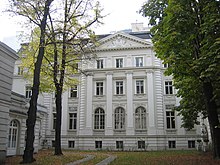
One of the smaller city houses, Vienna. A collection of far larger Viennese palaces known as Palais Rothschild were torn down during the Second World War.
In one instance, the family network enabled Nathan to receive in London the news of Wellington's victory at the Battle of Waterloo a full day ahead of the government's official messengers.[14] Rothschild's first concern on this occasion was to the potential financial advantage on the market which the knowledge would have given him; he and his courier did not immediately take the news to the government.[14] It was then repeated in later popular accounts, such as that of Morton.[16][17] The basis for the Rothschild's most famously profitable move was made after the news of British victory had been made public. Nathan Rothschild calculated that the future reduction in government borrowing brought about by the peace would create a bounce in British government bonds after a two year stabilisation, which would finalise the post-war restructuring of the domestic economy.[15][16][17] In what has been described as one of the most audacious moves in financial history, Nathan immediately bought up the government bond market, for what at the time seemed an excessively high price, before waiting two years, then selling the bonds on the crest of short bounce in the market in 1817 for a 40% profit. Given the sheer power of leverage the Rothschild family had at their disposal, this profit was an enormous sum.[15]
Nathan Mayer Rothschild initially started his business in Manchester England in 1806, and gradually moved it to London, where in 1809 he acquired the location at 2 New Court in St. Swithin's Lane, City of London,[14] where it operates today; he established N. M. Rothschild and Sons in 1811. In 1818, he arranged a £5 million loan to the Prussian government, and the issuing of bonds for government loans formed a mainstay of his bank’s business. He gained a position of such power in the City of London that by 1825–6 he was able to supply enough coin to the Bank of England to enable it to avert a market liquidity crisis.
[edit] International high finance
| "I have not the nerve for his operations. They are well-planned, with great cleverness and adroitness in execution – but he is in money and funds what Napoleon was in war." —Baron Baring on Nathan Rothschild[18] |
In 1847, Sir Anthony de Rothschild was made a hereditary baronet of the United Kingdom. In 1885, Nathan Mayer Rothschild II (1840–1915) of the London branch of the family, was granted the hereditary peerage title Baron Rothschild in the Peerage of the United Kingdom.
Major 19th century businesses founded with Rothschild family capital include:
- Alliance Assurance (1824) (now Royal & SunAlliance);
- Chemin de Fer du Nord (1845)
- The Rio Tinto mining company (1873) (From the 1880s onwards, the Rothschilds had full control of Rio Tinto)[19]
- Eramet (1880)
- Imerys (1880)
- De Beers (1888)
The Japanese government approached the London and Paris families for funding during the Russo-Japanese War. The London consortium's issue of Japanese war bonds would total £11.5 million (at 1907 currency rates; £902 million in 2012 currency terms).[20]
The name of Rothschild became synonymous with extravagance and great wealth, and the family was renowned for its art collecting, for its palaces, as well as for its philanthropy. By the end of the century, the family owned, or had built, at the lowest estimates, over 41 palaces, of a scale and luxury perhaps unparalleled even by the richest royal families.[15] The soon to be British Prime Minister Lloyd George claimed, in 1909, that Lord Nathan Rothschild was the most powerful man in Britain.[2][21]
In 1901, with no male heir, the Frankfurt House closed its doors after more than a century in business. It was not until 1989 that the family returned, when N M Rothschild & Sons, the British investment arm, plus Bank Rothschild AG, the Swiss branch, set up a representative banking office in Frankfurt.
[edit] English branch
Main article: Rothschild banking family of England
The Rothschild banking family of England was founded in 1798 by Nathan Mayer Rothschild (born 1777).[edit] French branches
Main article: Rothschild banking family of France

Château de Ferrières, the largest château of the 19th century, was built in 1854. It is set on a 30 km² estate. It was donated to charity by the family in 1975.
The first was son James Mayer de Rothschild (1792–1868), known as "James", who established de Rothschild Frères in Paris. Following the Napoleonic Wars, he played a major role in financing the construction of railroads and the mining business that helped make France an industrial power. James' sons Gustave de Rothschild and Alphonse James de Rothschild continued the banking tradition and was the guarantor of the 5 billion in reparations[22] demanded by the occupying Prussian army in the 1870s Franco-Prussian War.[citation needed] By 1980, the Paris business employed about 2,000 people and had an annual turnover of 26 billion francs ($5 billion in the currency rates of 1980).[23]
But then the Paris business suffered a near death blow in 1982 when the socialist government of François Mitterrand nationalised and renamed it Compagnie Européenne de Banque.[citation needed] Baron David de Rothschild, then 39, decided to stay and rebuild, creating a new entity Rothschild & Cie Banque with just three employees and $1 million in capital. Today the Paris operation has 22 partners and accounts for a significant part of the global business.
Ensuing generations of the Paris Rothschild family remained involved in the family business, becoming a major force in international investment banking. The Rothschilds have since led the Thomson Financial League Tables in Investment Banking Merger and Acquisition deals in the UK, France, and Italy.
James Mayer de Rothschild's other son, Edmond James de Rothschild (1845–1934) was very much engaged in philanthropy and the arts, and was a leading proponent of Zionism. His grandson, Baron Edmond Adolphe de Rothschild, founded in 1953 the LCF Rothschild Group, a private bank. Since 1997, Baron Benjamin de Rothschild chairs the group. The group has €100bn of assets in 2008 and owns many wine properties in France (Château Clarke, Château des Laurets), in Australia or in South Africa.In 1961, the 35 year old Edmond Adolphe de Rothschild purchased the company Club Med, after he had visited a resort and enjoyed his stay.[24][25] His interest in Club Med was sold off by the 1990s. In 1973, he bought out the Bank of California, selling his interests in 1984 before it was sold to Mitsubishi Bank in 1985.
| "No kings could afford this! It could only belong to a Rothschild."— Wilhelm I, Emperor of Germany, on visiting Château de Ferrières.[26] |
[edit] Austrian branch
Main article: Rothschild banking family of Austria

Grüneburgschlößchen, Frankfurt, 1845, one of the Rothschilds' many German garden-mansions. This particular estate was destroyed in an allied bombing raid, 1944.
[edit] Naples branch

Villa Pignatelli, Naples, with views onto Mount Vesuvius
Main article: Rothschild banking family of Naples
The C M de Rothschild & Figli bank arranged substantial loans to the Papal States and to various Kings of Naples plus the Duchy of Parma and the Grand Duchy of Tuscany. However, in the 1830s, Naples followed Spain with a gradual shift away from conventional bond issues that began to affect the bank's growth and profitability. The Unification of Italy in 1861, with the ensuing decline of the Italian aristocracy who had been the Rothschild's primary clients, eventually brought about the closure of their Naples bank, due to declining forecasts for long-term business sustainability. However, in the early 19th century, the Rothschild family of Naples built up close relations with the Vatican Bank, and the association between the family and the Vatican continued into the 20th century. In 1832, when Pope Gregory XVI was seen meeting Carl von Rothschild, observers were shocked that Rothschild was not required to kiss the Pope's feet, as was then required for all other visitors to the Pope, including monarchs.[28]| “ | "Rothschilds... are the guardians of the papal treasure."-Encyclopedia Judaica, 1901–1906, Vol. 2, p.497 | ” |
[edit] Jewish identity and positions on Zionism
Jewish solidarity in the family was not homogeneous. Some Rothschilds were supporters of Zionism, while other members of the family opposed the creation of the Jewish state. Lord Victor Rothschild was against granting asylum or even help to Jewish refugees during the Holocaust.[22] In 1917 Walter Rothschild, 2nd Baron Rothschild was the addressee of the Balfour Declaration to the Zionist Federation,[29] which committed the British government to the establishment in Palestine of a national home for the Jewish people.After the death of James Jacob de Rothschild in 1868, Alphonse Rothschild, his eldest son, who took over the management of the family bank, was the most active in support for Eretz Israel.[30] The Rothschild family archives show that during the 1870s the family contributed nearly 500,000 francs per year on behalf of Eastern Jewry to the Alliance Israélite Universelle.[31] Baron Edmond James de Rothschild, James Jacob de Rothschild's youngest son was a patron of the first settlement in Palestine at Rishon-LeZion, and bought from Ottoman landlords parts of the land which now makes up present-day Israel. In 1924, he established the Palestine Jewish Colonization Association (PICA), which acquired more than 125,000 acres (22,36 km²) of land and set up business ventures.[32] In Tel Aviv, he has a road, Rothschild Boulevard, named after him as well as various localities throughout Israel which he assisted in founding including Metulla, Zikhron Ya'akov, Rishon Lezion, and Rosh Pina. A park in Boulogne-Billancourt, Paris, the Parc Edmond de Rothschild (Edmond de Rothschild Park) is also named after its founder.[33] The Rothschilds also played a significant part in the funding of Israel's governmental infrastructure. James A. de Rothschild financed the Knesset building as a gift to the State of Israel[34] and the Supreme Court of Israel building was donated to Israel by Dorothy de Rothschild.[35] Outside the President's Chamber is displayed the letter Mrs. Rothschild wrote to the then current Prime Minister Shimon Peres expressing her intention to donate a new building for the Supreme Court.[36]
Interviewed by Haaretz in 2010, Baron Benjamin Rothschild, a Swiss-based member of the banking family, said that he supported the peace process: "I understand that it is a complicated business, mainly because of the fanatics and extremists – and I am talking about both sides. I think you have fanatics in Israel... In general I am not in contact with politicians. I spoke once with Netanyahu. I met once with an Israeli finance minister, but the less I mingle with politicians the better I feel." On the subject of religious identity, he stated that he held an open-minded attitude: "We do business with all kinds of countries, including Arab countries ... My oldest daughter's boyfriend is a Saudi. He is a great guy and if she will want to marry him, she can."[37]
[edit] Modern business
Since the late-19th century, the family has taken a low-key public profile, donating many famous estates, as well as vast quantities of art, to charity, and generally eschewing conspicuous displays of wealth. Today, Rothschild businesses are on a smaller scale than they were throughout the 19th century, although they encompass a diverse range of fields, including: banking, asset management, financial advice, wine, and charities.[6][7][edit] The Rothschild Group
Since 2003, a group of Rothschild banks have been controlled by Rothschild Continuation Holdings, a Swiss-registered holding company (under the chairmanship of Baron David René de Rothschild). Rothschild Continuation Holdings is in turn controlled by Concordia BV, a Dutch-registered master holding company. Concordia BV is managed by Paris Orléans S.A., a French-registered holding company.[38] Paris Orléans S.A. is ultimately controlled by Rothschild Concordia SAS, a Rothschild's family holding company.[39] Rothschild & Cie Banque controls Rothschild banking businesses in France and continental Europe, while Rothschilds Continuation Holdings AG controls a number of Rothschild banks elsewhere, including N M Rothschild & Sons in London. Twenty percent of Rothschild Continuation Holdings AG was sold in 2005 to Jardine Strategic, which is a subsidiary of Jardine, Matheson & Co. of Hong Kong. In November 2008, Rabobank Group, the leading investment and private bank in the Netherlands, acquired 7.5% of Rothschild Continuation Holdings AG, and Rabobank and Rothschild entered into a co-operation agreement in the fields of Mergers and Acquisitions (M&A) advisory and Equity Capital Markets advisory in the food and agribusiness sectors.[40] It was believed that the move was intended to help Rothschild Continuation Holdings AG gain access to a wider capital pool, enlarging its presence in East Asian markets.[41]Paris Orléans S.A. is a financial holding company listed on Euronext Paris and controlled by the French and English branch of the Rothschild family. Paris Orléans is the flagship of the Rothschild banking Group and controls the Rothschild Group's banking activities including N M Rothschild & Sons and Rothschild & Cie Banque. It has over 2000 employees. Directors of the company include Eric de Rothschild, Robert de Rothschild, and Count Philippe de Nicolay.[42]
N M Rothschild & Sons, English investment bank does most of its business as a mergers and acquisitions advisor. In 2004, the investment bank withdrew from the gold market, a commodity the Rothschild bankers had traded in for two centuries.[22] In 2006, it ranked second in UK M&A with deals totalling $104.9 billion.[43] In 2006, it publicly recorded a pre-tax annual profit of £83.2 million with assets of £5.5 billion.[44]
Today, the price of gold is still fixed twice a day, at 10.30 am and 3.00 pm, at the premises of N M Rothschild by the world's main Bullion Houses - Deutsche Bank, HSBC, ScotiaMocatta and Société Générale. Informally, the gold fixing provides a recognized rate that is used as a benchmark for pricing the majority of gold products and derivatives throughout the world's markets. Every day at 10.30 and 15.00 local time, five representatives of investment banks meet in a small room at Rothschild's London headquarters on St Swithin's Lane. In the centre is the chairperson, who is by tradition appointed by the Rothschild bank, although the bank itself has largely withdrawn from the trading.[45]
[edit] Edmond de Rothschild Group

The Large Mansion at Gunnersbury Park, London
In late 2010, Baron Benjamin Rothschild said that the family had been unaffected by the financial crisis of 2007–2010, due to their conservative business practices: "We came through it well, because our investment managers did not want to put money into crazy things." He added that the Rothschilds were still a small-scale, traditional family business, and took greater care over their clients' investments than American companies, adding: "The client knows we will not speculate with his money".[37][46]
Edmond de Rothschild group includes these companies.
- Banque privée Edmond de Rothschild - Swiss private banking firm
- Compagnie Financière Edmond de Rothschild - French private bank
- La Compagnie Benjamin de Rothschild
- Cogifrance - Real estate
- Compagnie Vinicole Baron Edmond de Rothschild - Wine making firm
[edit] RIT Capital Partners
In 1980, Jacob Rothschild, 4th Baron Rothschild resigned from N M Rothschild & Sons and took independent control of Rothschild Investment Trust (now RIT Capital Partners, one of the UK's largest investment trusts), which has reported assets of $3.4 billion in 2008.[47] It is listed on London Stock Exchange. Lord Rothschild is also one of the major investors behind BullionVault, a gold trading platform.[48]RIT Capital stores a significant proportion of its assets in the form of physical gold. Other assets include oil and energy-related investments.[49]
[edit] Investment
In 1991, Jacob Rothschild, 4th Baron Rothschild founded J. Rothschild Assurance Group (now St. James's Place) with Sir Mark Weinberg. It is also listed on London Stock Exchange.[50]In 2001, the Rothschild mansion located at 18 Kensington Palace Gardens, London, was on sale for £85 million, at that time (2001) the most expensive residential property ever to go on sale in the world. It was built in marble, at 9,000sq ft, with underground parking for 20 cars.[51]
In December 2009, Jacob Rothschild, 4th Baron Rothschild invested $200 million of his own money in a North Sea oil company.[52]
In January 2010, Nathaniel Philip Rothschild bought a substantial share of the Glencore mining and oil company's market capitalization. He is also buying a large share of the aluminium mining company United Company RUSAL.[53]
During the 19th century, the Rothschilds controlled the Rio Tinto mining corporation, and to this day, Rothschild and Rio Tinto maintain a close business relationship.
In 2012, RIT Capital Partners announced that it is to buy a 37 per cent stake in a Rockefeller family wealth advisory and asset management group. The deal, focusing on asset-management, marks the first time that these two well-known families have collaborated.[54] Commenting on the deal, David Rockefeller, a current patriarch of Rockefeller family, said: "The connection between our two families remains very strong."[55]
[edit] Wine

Château Lafite Rothschild, Bordeaux. Alongside Château Mouton Rothschild, it is perhaps the most prestigious of the many Rothschild wine estates
Today Rothschild family owns many wine estates: their estates in France include Château Clarke, Château Clerc-Milon, Château d'Armailhac, Château Duhart-Milon, Château Lafite Rothschild, Château de Laversine, Château des Laurets, Château L'Évangile, Château Malmaison, Château de Montvillargenne, Château Mouton Rothschild, Château de la Muette, Château Rieussec, Château Rothschild d'Armainvilliers. They also own wine estates across North America, South America, South Africa and Australia.
Especially, Château Mouton Rothschild and Château Lafite Rothschild are classified as Premier Cru Classé -- i.e., First Growth, the status referring to a classification of wines primarily from the Bordeaux region of France.
[edit] Art and charity
The family once had one of the largest private art collections in the world, and a significant proportion of the art in the world's public museums are Rothschild donations which were sometimes, in the family tradition of discretion, donated anonymously.[57][edit] Cultural references

The Neo-Gothic Castle de Haar

The Neo-Gothic Rothschildschloss, Waidhofen
In France, the word "Rothschild" was throughout the 19th and 20th centuries a synonym for seemingly endless wealth, neo-Gothic styles, and epicurean glamour.[59] The family also has lent its name to "le goût Rothschild," a suffocatingly glamorous style of living whose decorative elements include neo-Renaissance palaces, extravagant use of velvet and gilding, vast collections of armour and sculpture, a sense of Victorian horror vacui, and the highest masterworks of art. Le goût Rothschild has much influenced designers such as Robert Denning, Yves Saint Laurent, Vincent Fourcade, and others.
"Yes, my dear fellow, it all amounts to this: in order to do something first you must be something. We think Dante great, and he had a civilisation of centuries behind him; the House of Rothschild is rich and it has required much more than one generation to attain such wealth. Such things all lie much deeper than one thinks."—Johann Wolfgang von Goethe, October 1828[60]
| This section requires expansion. (July 2011) |
[edit] Conspiracy theories
Over more than two centuries,[16][17] the Rothschild family has frequently been the subject of conspiracy theories.[61][62][63] These theories take differing forms, such as claiming that the family controls the world's wealth and financial institutions,[64][65] or encouraged or discouraged wars between governments. Discussing this and similar views, the historian Niall Ferguson wrote, "As we have seen, however, wars tended to hit the price of existing bonds by increasing the risk that a debtor state would fail to meet its interest payments in the event of defeat and losses of territory. By the middle of the 19th century, the Rothschilds had evolved from traders into fund managers, carefully tending to their own vast portfolio of government bonds. Now having made their money, they stood to lose more than they gained from conflict. The Rothschilds had decided the outcome of the Napoleonic Wars by putting their financial weight behind Britain. Now they would sit on the sidelines."[66][edit] Prominent descendants of Mayer Amschel Rothschild
See also: Genealogy of the Rothschild family
Prominent lineal descendants of Mayer Amschel Rothschild include amongst many others:- This is an incomplete list, which may never be able to satisfy particular standards for completeness. You can help by expanding it with reliably sourced entries.

Baron David René de Rothschild, current French chairman of N M Rothschild & Sons and formerly of De Beers

Halton House, a Rothschild family mansion in Buckinghamshire, England

Lionel de Rothschild, whose colt won the 1879 Epsom Derby

Palace of Baron Albert von Rothschild, Vienna, (photo 1884)

Palace Nathaniel Rothschild, Vienna

Hôtel Salomon de Rothschild, Paris
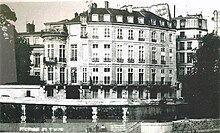
Hôtel Lambert, Paris
- Major Alexander Karet, (1905–1976)[67][68]
- Princess Agnès de La Tour d'Auvergne-Lauraguais, (born 1972)
- Prince Alexandre Louis Philippe Marie Berthier, (1883–1918), died fighting in World War I
- Albert Salomon von Rothschild (1844–1911), the once majority shareholder of Creditanstalt
- Alfred Charles de Rothschild (20 July 1842 – 31 January 1918)
- Alice Charlotte von Rothschild (1847–1922) close friend of Queen Victoria
- Aline Caroline de Rothschild (1865–1909), French socialite
- Alice Rothschild (1985-), a Rothschild and the partner of Zac Goldsmith, after his divorce of Sheherazade Ventura-Bentley[69]
- Lady Aline Caroline Cholmondeley (1916–)[citation needed]
- Baroness Afdera Franchetti (born c. 1931), a former wife of Henry Fonda, from the noble Italian Jewish Franchetti family
- Baroness Alix Hermine Jeannette Schey de Koromla (1911–1982)[70]
- Alphonse James de Rothschild (1827–1905)
- Amschel Mayor James Rothschild (1955–1996, Paris), patron of motor racing
- Princess Andréa de La Tour d'Auvergne-Lauraguais (born Paris 1972)[citation needed]
- Anthony Gustav de Rothschild (1887–1961), horse-breeder
- Anthony James de Rothschild (born 1977)
- Anselm von Rothschild (1803–1874), Austrian banker
- Anselm Alexander Carl de Rothschild (1835–1854)[citation needed]
- Sir Anthony de Rothschild, 1st Baronet (1810–1876)
- Antoine Armand Odélric Marie Henri de Gramont, 13th Duke of Gramont, (1951–)[71]
- Alain James de Rothschild (1910–1982)[citation needed]
- Lady Barbara Marie-Louise Constance Berry (born 1935)
- Count Armand de Cossé-Brissac (1967–)
- Miriam Caroline Alexandrine de Rothschild
- Lord Charles Robert Archibald Grant
- Ariane de Rothschild
- Ariella de Rothschild
- Arthur de Rothschild (1851–1903)
- Benjamin de Rothschild (born 1963, Paris)
- Princess Béatrice de Broglie (born 1913)
- Béatrice Ephrussi de Rothschild (1864–1934)
- Bethsabée de Rothschild (1914–1999)
- Carl Mayer von Rothschild (1788–1855)
- Cécile Léonie Eugénie Gudule Lucie de Rothschild (1913–1995)
- Charlotte de Rothschild
- Charlotte Henriette de Rothschild (born 1955), British opera singer
- Charlotte von Rothschild(1818–84)
- Count Charles-Emmanuel Lannes de Montebello (born 1942)
- Charles Rothschild (1877–1923), banker and entomologist
- Constance Flower, 1st Baroness of Battersea, (1843–1931)[citation needed]
- David Cholmondeley, 7th Marquess of Cholmondeley (1960–), Lord Great Chamberlain of England
- David Mayer de Rothschild (b. 1978), billionaire[72] British adventurer and environmentalist
- David René de Rothschild (born 1942)
- Diane Cécile Alice Juliette de Rothschild (1907–)[citation needed]
- Edmond Adolphe de Rothschild
- Edouard Etienne de Rothschild, (born 1957)
- Édouard Alphonse James de Rothschild (1868–1949) financier and polo player
- Prince Edouard de La Tour d'Auvergne-Lauraguais, (1949–)
- Edmond James de Rothschild (1845–1934)
- Edmund Leopold de Rothschild (1916–2009)
- Elie de Rothschild (1917–2007)
- Princess Elisabeth de Broglie (1920–)
- Elisabeth Clarice de Rothschild (born 1952)
- Emma Rothschild (born 1948)
- Esther de Rothschild (born 1979)
- Evelina de Rothschild(1839–66)
- Evelyn Achille de Rothschild (1886–1917), died fighting for the British army in World War I
- Sir Evelyn de Rothschild (born 1931), banker
- Francesca Diane de Rothschild (1919-1998), philanthropist
- Count Gabriel Antoine Armand, (1908–1943), a soldier of the French Resistance.
- Guy de Rothschild (1909–2007)
- Baron Ferdinand de Rothschild (1839–1898)
- Hannah Primrose, Countess of Rosebery née Hannah Rothschild (1851–1890)
- Heidi Magdalena de Rothschild (1933), socialite
- Henry Herbert, 7th Earl of Carnarvon, (1924–2001)
- Henri James de Rothschild (1872–1946)
- Henry Herbert, 6th Earl of Carnarvon (1898–1987)
- Duke Hélie Marie Auguste Jacques Bertrand Philippe, (1943), 10th Duke of Noailles
- Henriette Rothschild (1791–1866) married Sir Moses Montefiore (1784–1885)
- Count Henri de Gramont (1909–1994)[citation needed]
- Hugh Cholmondeley, 6th Marquess of Cholmondeley (1919–90), Lord Great Chamberlain of England
- Jacob Rothschild, 4th Baron Rothschild, (born 1936), investment banker
- James Armand de Rothschild (1878–1957)
- James Mayer Rothschild (1792–1868)
- Joachim Von Rothschild (1929–1998)
- Julius de Rothschild (1981-)
- Lady Lavinia Anne Alix de Rothschild, of the Rothschild and Borghese family
- Neil Primrose, 7th Earl of Rosebery (1929–)
- Neil James Archibald Primrose (1882–1917), MP, killed fighting in World War I
- Nelly Rachel de Rothschild (born 1947)
- Baroness Nica de Koenigswarter (née Baroness Pannonica Rothschild) (1913–1988), patron of bebop and jazz writer - often called "The Jazz Baroness"
- Baron Léon Lambert (1929–1987), Belgium art collector[73]
- Lamasnipes de Rothschild (1844–1915)
- Leopold de Rothschild (1845–1917)
- Leopold David de Rothschild (1927–)
- Leonora de Rothschild (1837–1911)
- Lionel Nathan Rothschild (1808–1879)
- Louis Nathaniel de Rothschild (1882–1955)
- Countess Magdalene-Sophie von Attems, (1927–)
- Maria de Rothschild (1894-1937)
- Marie-Hélène de Rothschild (1927–94), French socialite
- Mayer Amschel de Rothschild (1818–1874)
- Marguerite Corisande Alexandrine Marie de Gramont (1920–1998), later Baroness de Gunzbourg, daughter of the Count de Gramont, Officier of Légion d'honneur and Croix de guerre
- Maria Beatrice de Rothschild, grand-daughter of the Princess de Marsiconovo
- Miriam Louisa Rothschild (1908–2005), famous entomologist and zoologist
- Lionel Walter Rothschild, 2nd Baron Rothschild of the United Kingdom (1868–1937)
- Nathaniel de Rothschild (1812–1870)
- Nathan Mayer Rothschild (1777–1836)
- Nathan Mayer Rothschild, 1st Baron Rothschild of the United Kingdom (1840–1915)
- Nathaniel Charles Jacob Rothschild, 4th Baron Rothschild of the United Kingdom (born 1936)
- Nathaniel Robert de Rothschild (1946), French financier
- Nathaniel Mayer Victor Rothschild, 3rd Baron Rothschild of the United Kingdom (1910–1990)
- Nathaniel Philip Rothschild (born 1971), a co-chairman of Atticus Capital, a £20 billion hedge fund[74]
- Nathaniel Anselm von Rothschild (1836–1905), Austrian socialite
- Sir Philip Sassoon, 3rd Baronet (1888–1939), British First Commissioner of Works and Under-Secretary of State for Air
- Count Philippe de Nicolay (born 1955), great-grandson of Salomon James de Rothschild, he is a director of the Rothschild group.[42]
- Philippe de Rothschild (1902–1988), vintner
- Philippine de Rothschild (born 1935), vintner
- Jacqueline Rebecca Louise de Rothschild, born 6 November 1911, chess and tennis champion
- Harry Primrose, 6th Earl of Rosebery (1882–1974) Earl of Roseberry
- Raphael de Rothschild (1976–1997)
- Salomon James de Rothschild, (1835–1864)
- Lady Serena Dunn Rothschild, (born 1935)
- Countess Sophie von Löwenstein-Scharffeneck, (1896–1978)
- Lady Sybil Grant (1879–1955), British writer
- Sybil Cholmondeley, Marchioness of Cholmondeley, (1894–1989)
- Valentine Noémi von Springer, (1886, d. 1969)
- Victoria Katherine Rothschild (1953–)
- Walter Rothschild, 2nd Baron Rothschild, zoologist
- Wilhelm Carl von Rothschild
- Zachary Ryan de Rothschild (1997-)
- Philippe Michael von Krause
- Hannah Rothschild, writer and documentary film-maker (born 1962)
Prominent marriages into the family include, amongst many others:
- This is an incomplete list, which may never be able to satisfy particular standards for completeness. You can help by expanding it with reliably sourced entries.
- Maurice Ephrussi (1849–1916), of the Ephrussi banking dynasty[75]
- Ben Goldsmith (1980–), son of financier James Goldsmith
- Anita Patience Guinness (1957), of the Guinness family, married Amschel Mayor James Rothschild[76]
- Cora Guggenheim (1873–1956), of the Guggenheim family, married Louis F. Rothschild (1869–1957)
- Abraham Oppenheim (1804–1878), of the Oppenheim Family, married Charlotte Beyfus (1811–1887)
- Aline Caroline de Rothschild (1865–1909) married Sir Edward Sassoon, 2nd Baronet, of Kensington Gore (1856–1912), of the Sassoon family
- Carola Warburg Rothschild (1894–1987), philanthropist, born into the Warburg family[77]
- Sara Louise de Rothschild (born 1834), married the Baron Raimondo Franchetti (born 1829)
- Baron Eugène de Rothschild (1884-1976) married Countess Kitty Wolff de Schonborn-Bucheim (1885-)[78]
- Bertha Clara de Rothschild (1862) married Prince Alexandre de Wagram
- Bertha Juliet de Rothschild (1870) married Baron Emmanuel Leonino
- Lili Jeanette von Goldschimdt-Rothschild (1883-1929), married Baron Philippe Schey de Koromla
- Elisabeth Pelletier de Chambure (1902–1945), the only member of the Rothschild family to die in the holocaust.
- Antoine Agénor Armand (1879–1962), of the Naples Rothschild lines, married Countess Élaine Greffulhe, daughter of Princess Élisabeth de Caraman-Chimay
- Hannah Mayer Rothschild (1815–1864) married Hon. Henry Fitzroy (1807–1859), of the family of the Dukes of Grafton
- Edouard Alphonse James de Rothschild (1868-1949) married in 1905 the Baroness Alice Germaine de Halphen (1884-1979)
- Count François de Nicolay (1919–1963), of the House of Nicolay, married Marie-Hélène Naila Stephanie Josina van Zuylen van Nyevelt
- Marguerite de Rothschild in 1878 married Antoine Alfred Agénor, 11th Duc de Gramont, (1851–1921),
- Dorothy de Rothschild (1895–1988), on her death she left the largest probated estate in Britain
- George Herbert, 5th Earl of Carnarvon married Almina Victoria Maria Alexandra Wombwell, the illegitimate daughter of Alfred de Rothschild
- Pauline de Rothschild (1908–1976), fashion designer and translator of Elizabethan poetry
- In 1923, James Nathaniel Charles Léopold Rothschild, son of Henri James Nathaniel Charles Rothschild and Mathilde Sophie Henriette de Weisweiller, married Claude du Pont of the Du Pont family.[79]
- Lady Irma Pauahi Wodehouse (1897), of the Wodehouse family[70]
- Prince Louis Philippe Berthier, (1836–1911)
- Jeanne de Rothschild (1908–2003), actress
- Nadine de Rothschild (1932- ), French actress and author
- Princess Sophie de Ligne (1957–), of the House of Ligne, married Philippe de Nicolay (born 1955), a director of the Rothschild group,[42] and the great-grandson of Salomon James de Rothschild
- Liliane de Rothschild (1916–2003) art collector
- David Rene de Rothschild married Princess Olimpia Anna Aldobrandini, of the House of Borghese and the House of Bonaparte.[70]
- Baron Robert Philippe de Rothschild married Nelly Beer, a great-grand-niece of Giacomo Meyerbeer
- Richard Francis Roger Yarde-Buller, 4th Baron Churston of Churston Ferrers and Lupton, (1910–1991), married Olga Alice Muriel Rothschild
- Serena Dunn Rothschild (b. 1935), grand-daughter of Sir James Hamet Dunn, 1st Baronet
- Lynn Forester de Rothschild (born 1954), business woman
- Edward Maurice Stonor (1885–1930), son of Francis Stonor, 4th Baron Camoys[citation needed]
- Lady Pamela Wellesley Grant, (born 1912), great-great-grand-daughter of The Duke of Wellington, married Lieutenant Charles Robert Archibald Grant, great-great-grandson of Mayer Amschel de Rothschild
- Baroness Rozsika Edle von Wertheimstein[4]
- Count Etienne van Zuylen van Nijevelt of the House of Van Zuylen van Nijevelt – married Baroness Hélène de Rothschild (1863–1947).[80]
- Baron Sigismund von Springer (1873–1927), married Baroness Valentine Noémi von Rothschild (1886–1969), after whom the asteroid 703 Noëmi is named
- In 1943 Baron Elie Robert de Rothschild (1917–2007), married Lady Liliane Elisabeth Victoire Fould-Springer, grand-aunt of actress Helena Bonham Carter[81]
[edit] See also
- Ascott House
- Avenue Foch
- Bethmanns and Rothschilds
- Cecil John Rhodes
- Château de Montvillargenne
- Château Lafite-Rothschild
- Château Mouton Rothschild
- De Beers
- Eramet
- Hôtel de Marigny
- Hôtel Salomon de Rothschild
- Hotel Lambert
- Imerys
- Napoleonic Wars
- Old Money
- Palais Rothschild
- Rothschild (Fabergé egg)
- Rothschild properties in and around Buckinghamshire
- Rio Tinto Mining Group
- The House of Rothschild (1934 film), addresses Rothschild roles in the Napoleonic era
- Vaux-de-Cernay Abbey
[edit] Notes
- ^ The House of Rothschild: Money's prophets, 1798–1848, Volume 1, Niall Ferguson, 1999, introduction
- ^ a b c The House of Rothschild: Money's prophets, 1798–1848, Volume 1, Niall Ferguson, 1999, page 481-85
- ^ The Independent, UK: The Rothschild story: A golden era ends for a secretive dynasty
- ^ a b The secret life of the Jazz Baroness, From The Times 11 April 2009, Rosie Boycott
- ^ Rothschild: a story of wealth and power, by Derek A. Wilson, (Deutsch 1988), pages 415-456
- ^ a b The Rothschilds: Portrait of a Dynasty, By Frederic Morton, page 11
- ^ a b Million-pound bash for rising star of the super-rich
- ^ Pohl, Manfred (2005) (in German). "Rothschild, Mayer Amschel ". In Neue Deutsche Biographie (NDB). 22. Berlin: Duncker & Humblot. pp. 131–133.
- ^ "Concordia, Integritas, Industria – The Rothschilds – LCF Rothschild Group". Lcf-rothschild.com. Archived from the original on 24 October 2007. http://web.archive.org/web/20071024114837/http://www.lcf-rothschild.com/en/groupe/rothschild/concordia.asp. Retrieved 8 July 2010.
- ^ Paul Johnson, A History of the Jews, p.317.
- ^ The House of Rothschild (Vol. 2): The World's Banker: 1849-1999, Niall Ferguson (2000)
- ^ Jewish Encyclopedia c.1906 Finance
- ^ Go Ahead, Kiss Your Cousin by Richard Conniff, From the August 2003 issue, published online 1 August 2003
- ^ a b c d Victor Gray and Melanie Aspey, "Rothschild, Nathan Mayer (1777–1836)", Oxford Dictionary of National Biography, Oxford University Press, September 2004; online edition, May 2006. Retrieved 21 May 2007.
- ^ a b c d The Ascent of Money: A Financial History of the World, (London 2008), page 78.
- ^ a b c Victor Rothschild – "The Shadow of a Great Man" in Random Variables, Collins, 1984.
- ^ a b c *Ferguson, Niall. The World's Banker: The History of the House of Rothschild. Weidenfeld & Nicolson, 1998, ISBN 0-297-81539-3
- ^ Philip Ziegler, The Sixth Great Power: Barings, 1726–1929, (London 1988), pp.94f
- ^ The Rio Tinto Company: an economic history of a leading international mining concern, Charles E. Harvey (1981), page 188
- ^ Smethurst, Richard. "Takahasi Korekiyo, the Rothschilds and the Russo-Japanese War, 1904–1907". http://www.rothschildarchive.org/ib/articles/AR2006Japan.pdf. Retrieved 4 September 2007.
- ^ A History of the Jews, Paul Johnson (London 2004), page 319-20
- ^ a b c Vallely, Paul (16 April 2004). "The Rothschild story: A golden era ends for a secretive dynasty". London: The Independent. http://www.independent.co.uk/news/uk/this-britain/the-rothschild-story-a-golden-era-ends-for-a-secretive-dynasty-756388.html. Retrieved 18 February 2010.
- ^ RPT-French banker Guy de Rothschild dies aged 98 Reuters, Thu 14 Jun 2007 12:26 pm EDT
- ^ Faith, Nicholas (4 November 1997). "Obituary: Baron Edmond de Rothschild". The Independent (UK). http://www.independent.co.uk/news/obituaries/obituary-baron-edmond-de-rothschild-1292054.html. Retrieved 29 March 2009.
- ^ Gilbert Trigano, a Developer of Club Med, Is Dead at 80 By JOHN TAGLIABUE Published: 6 February 2001
- ^ Lafite; the story of Château Lafite-Rothschild, by Cyril Ray (NY 1969), page 66.
- ^ Thomas Trenkler. Der Fall Rothschild: Chronik einer Enteignung. Czernin Verlag, Vienna. 1999. ISBN 3-85485-026-3
- ^ The reign of the house of Rothschild, Egon Caesar Corti (Conte), 1928, page 46
- ^ Balfour Declaration. (2007). In Encyclopædia Britannica. Retrieved 12 August 2007, from Encyclopædia Britannica Online.
- ^ Aharonson, Ran (2000). Rothschild and early Jewish colonization in Palestine. Israel: The Hebrew university Magnes Press, Jerusalem. p. 53. ISBN 0-7425-0914-1.
- ^ Aharonson, Ran (2000). Rothschild and early Jewish colonization in Palestine. Israel: The Hebrew university Magnes Press, Jerusalem. p. 54. ISBN 0-7425-0914-1.
- ^ Encyclopedia of Zionism and Israel, vol. 2, "Rothschild, Baron Edmond-James de," p.966
- ^ Greenwood, Naftali. "The Redeemers of the Land". Israel Ministry of Foreign Affairs. http://www.mfa.gov.il/MFA/History/Modern+History/Centenary+of+Zionism/The+Redeemers+of+the+Land.htm. Retrieved 8 April 2010.
- ^ "James Armand de Rothschild on the Knesset web site". Knesset.gov.il. http://www.knesset.gov.il/lexicon/eng/rotchild_ja_eng.htm. Retrieved 8 July 2010.
- ^ "Dorothy de Rothschild, 93, Supporter of Israel" (obituary), The New York Times, 13 December 1988. Retrieved 19 June 2008.
- ^ The Presidents Chamber, Tour of Supreme Court, The Judicial Authority. http://elyon1.court.gov.il/eng/home/index.html.
- ^ a b Family values, Haaretz, Magazine, 11:15 05.11.10, By Eytan Avriel and Guy Rolnik
- ^ "Banking activities organisation chart of Rothschild". Paris-orleans.com. http://www.paris-orleans.com/en-gb/activites/activites-bancaires.html.
- ^ "Paris Orléans Annual report 2007/2008". Paris-orleans.com. http://www.paris-orleans.com/upload/2007_2008/031208_PO_UK_RA07_08_MEL.pdf. Retrieved 31 July 2008.
- ^ See: http://www.rabobank.com/content/news/news_archive/020-RothschildandRabobankestablishglobalfoodandagricooperation.jsp
- ^ "Rothschild sells 7.5% stake to Rabobank". FT Alphaville. 2008. http://ftalphaville.ft.com/blog/2008/11/20/18451/rothschild-sells-75-stake-to-rabobank/. Retrieved 20 November 2008.
- ^ a b c People: Paris Orleans S.A. (PROR.PA)Reuters Finance
- ^ "League tables". Rothschild.com. http://www.rothschild.com/investmentbanking/ibleague.asp?id=ib-regional-manda. Retrieved 8 July 2010.
- ^ Annual Report of N M Rothschild & Sons Limited for the year ended 31 March 2006.
- ^ http://news.bbc.co.uk/1/hi/business/3628971.stm bbc.co.uk, Thursday, 15 April 2004, 13:29 GMT 14:29 UK
- ^ A Very Intriguing Rothschild Interview
- ^ "RIT Capital Partners". Miranda.hemscott.com. 28 October 2003. http://miranda.hemscott.com/servlet/HsPublic?context=ir.access.jsp&ir_client_id=1874&ir_option=DIRECTORS. Retrieved 8 July 2010.
- ^ Lord Rothschild fund joins World Gold Council to put £12.5m into BullionVaultThe Telegraph, By Garry White, 11:26PM BST 20 Jun 2010
- ^ Rothschild's RIT Capital Boosts Gold Investments as Net Asset Value Climbs Bloomberg, 17 November 2010, 3:25 AM EST
- ^ Peippo, Kathleen (2000). "St. James's Place Capital, plc , International Directory of Company Histories , Find Articles at BNET.com". Findarticles.com. http://findarticles.com/p/articles/mi_gx5202/is_2000/ai_n19122975. Retrieved 8 July 2010.
- ^ If you have to ask the price The Daily Telegraph, By Ross Clark, 1 Aug 2001
- ^ Rothschild backs North Sea oil trio From The Sunday Times 6 December 2009
- ^ Bloomberg Businessweek, Glencore May Expand to Rival BHP, Rothschild Says 6 January 2010, Simon Casey
- ^ Rockefellers and Rothschilds uniteFinancial Times, By Daniel Schäfer in London, 29 May 2012 11:46 pm
- ^ Transatlantic alliance between Rothschilds and Rockefellers for wealth management Tom Bawden, Thursday 31 May 2012, The Independent
- ^ Wine of Rothschild
- ^ The Rothschilds: Portrait of a Dynasty, By Frederic Morton, page 11-13
- ^ Daily Telegraph,The Rothschilds: They prefer to let their money do the talking, William Langley, Published: 9:59 pm BST 25 Oct 2008
- ^ The Rothschilds: Portrait of a Dynasty, By Frederic Morton (1998), page 5
- ^ Ferguson, ch.1
- ^ The Rough Guide to Conspiracy Theories, James McConnachie, Robin Tudge Edition: 2 – 2008
- ^ Levy, Richard S. (2005). Antisemitism: A Historical Encyclopedia of Prejudice. ABC-CLIO. p. 624. ISBN 1-85109-439-3.
- ^ Poliakov, Leon (2003). The History of Anti-semitism: From Voltaire to Wagner. University of Pennsylvania Press. p. 343. ISBN 0-8122-1865-5.
- ^ Brustein, William (2003). Roots of hate. Cambridge University Press. p. 147. ISBN 0-521-77478-0.
- ^ Perry, Marvin (2002). Antisemitism: Myth and Hate from Antiquity to the Present. Palgrave Macmillan. p. 117. ISBN 0-312-16561-7.
- ^ The Ascent of Money: A Financial History of the World, (London 2008), page 91.
- ^ Morton, Fredreric (1962)The Rothschilds; A Family Portrait, Secker & Warburg;London, UK
- ^ Burke's Peerage, Baronetage & Knightage-96th Ed-1938
- ^ All in this together? Osborne is skiing, Zac Goldsmith is in £8k-a-week villa and Mr Speaker hosting a lavish party for MPs as Britain faces year of austerity By Simon Walters and Lara Gould, Daily Mail 2 January 2011
- ^ a b c 1.[S37] Charles Mosley, editor, Burke's Peerage, Baronetage & Knightage, 107th edition, 3 volumes (Wilmington, Delaware, U.S.A.: Burke's Peerage (Genealogical Books) Ltd, 2003), volume 3, page 3416. Hereinafter cited as Burke's Peerage and Baronetage, 107th edition.
- ^ Francesco Rapazzini, Élisabeth de Gramont, Paris, Fayard, 2004.
- ^ Eco-warrior sets sail to save oceans from 'plastic death'The Observer, Sunday 12 April 2009, Robin McKie
- ^ Anne-Myriam Dutrieue, Le baron Léon Lambert, un banquier et financier belge d’envergure internationale du XXe siècle, 2010
- ^ The Rothschilds and their 200 years of political influence By Andy McSmith, Thursday, 23 October 2008, The Independent
- ^ Grand fortunes: dynasties of wealth in France, (Algora Publishing, 1998), By Michel Pinçon, Monique Pinçon-Charlot, Andrea Lyn Secara, page 124
- ^ Young love will cement marriage of Britain's top three dynasties Ingrid Mansell, The Times 21 April 2003
- ^ Carola W. Rothschild, Ex-Girl Scout Official NY Times, Published: Tuesday, 1 September 1987
- ^ DRUON Maurice, "Ces Messieurs de Rothschild", Paris 1966
- ^ Charles Mosley, editor, Burke's Peerage, Baronetage & Knightage, 107th edition, 3 volumes (Wilmington, Delaware, U.S.A.: Burke's Peerage (Genealogical Books) Ltd, 2003), volume 3, page 3417. Hereinafter cited as Burke's Peerage and Baronetage, 107th edition.
- ^ Baron Etienne van Zuylen van Nijevelt van de Haar and baroness Hélène de Rothschild
- ^ Charles Mosley, editor, Burke's Peerage, Baronetage & Knightage, 107th edition, 3 volumes (Wilmington, Delaware, U.S.A.: Burke's Peerage (Genealogical Books) Ltd, 2003), volume 3, page 3416. Hereinafter cited as Burke's Peerage and Baronetage, 107th edition.
[edit] Further reading
- Niall Ferguson: The House of Rothschild: Money's Prophets, 1798–1848 (ISBN 0-14-024084-5)
- Niall Ferguson: The House of Rothschild: The World's Banker, 1849–1998 (ISBN 0-14-028662-4)
- Frederic Morton: The Rothschilds: Portrait of a Dynasty (ISBN 1-56836-220-X)
- Amos Elon: Founder: A Portrait of the First Rothschild and His Time, 1996. (ISBN 0-670-86857-4)
- Egon Caesar Conte Corti: Rise of the House of Rothschild, B. Lunn (translator), Books for Business 2001 (reprint of 1928 translation published by Gollancz), ISBN 978-0894990588, Amazon.co.uk searchable online view
- Joseph Valynseele & Henri-Claude Mars, Le Sang des Rothschild, L’Intermédiaire des Chercheurs et Curieux, Paris, 2004 (ISBN 2-908003-22-8)
- Derek A. Wilson: Rothschild: A Story of Wealth and Power (ISBN 0-233-98870-X)
[edit] Documentary film
- Ascent of Money: A Financial History of the World – The early history of the Rothschild's family business feature in the second of a four part series by Niall Ferguson, aired on Channel Four
[edit] External links
| Wikisource has the text of the 1911 Encyclopædia Britannica article Rothschild. |
Finance
- RIT Capital Partners - English investment trust founded by English Rothschild family
- The Xander Group - Global investment firm founded by Rothschild family and Getty family
- The Rothschild Group - It includes activities of Rothschild & Cie Banque and N M Rothschild & Sons
- Paris Orléans S.A. - The flagship holding company of The Rothschild Group
- Rothschild Wealthmanagement & Trust - Wealth management branch of The Rothschild Group
- Edmond de Rothschild Group - Swiss private banking group founded by French Rothschild family
- Finance
- Banque privée Edmond de Rothschild - Swiss private banking firm
- Compagnie Financière Edmond de Rothschild - French private bank
- La Compagnie Benjamin de Rothschild
- Cogifrance - Real estate
- The Capital Holdings Funds -Flagship investment vehicle of the Edmond de Rothschild Group
- Non-finance
- Dmaine du Mont D'arbois - Luxury hotel
- Mont d'Arbois golf - Golf
- Gitana Team - Yacht racing
- Finance
- Baron Philippe de Rothschild SA (Château Mouton Rothschild)
- Domaines Barons de Rothschild (Château Lafite Rothschild)
- Compagnie Vinicole Baron Edmond de Rothschild (Château Clarke) - Edmond de Rothschild Group
- Rupert & Rothschild Vignerons
- Waddesdon Manor (England)
- Ascott House (England)
- Villa Rothschild Kempisnki (Germany)
- Villa Ephrussi de Rothschild (France)
- Château de Montvillargenne (France)
- Château de Ferrières (France)
- Hôtel Salomon de Rothschild (France)
- Exbury Gardens (England)
| ||||||||||||||

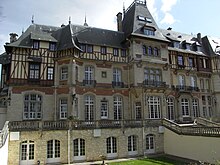
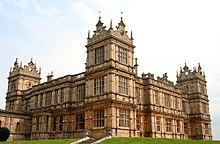

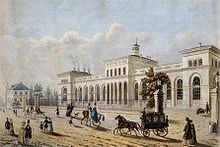

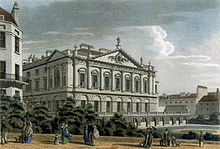





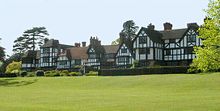

No comments:
Post a Comment